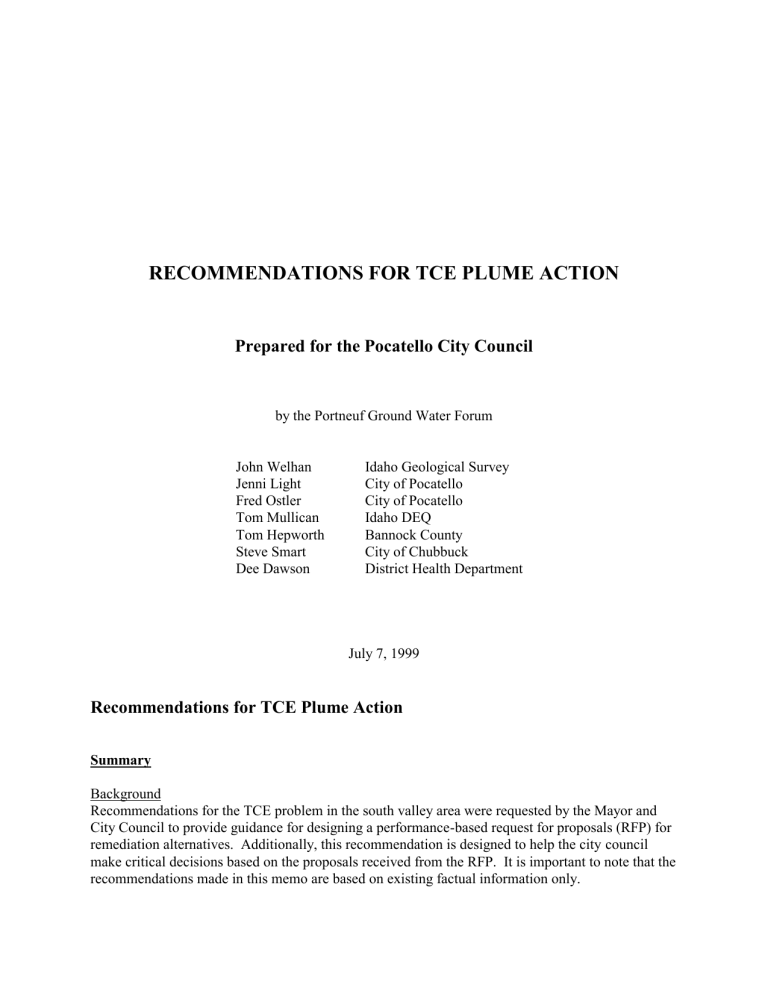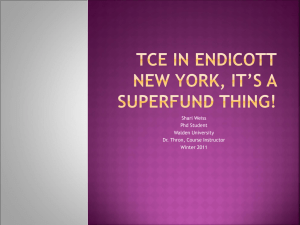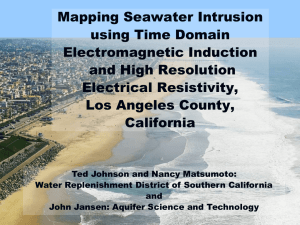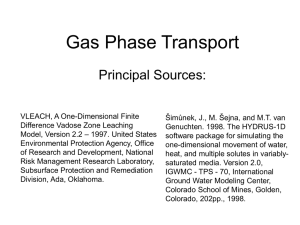A report on the TCE problem

RECOMMENDATIONS FOR TCE PLUME ACTION
Prepared for the Pocatello City Council
by the Portneuf Ground Water Forum
John Welhan
Jenni Light
Idaho Geological Survey
City of Pocatello
Fred Ostler
Tom Mullican
Tom Hepworth
Steve Smart
Dee Dawson
City of Pocatello
Idaho DEQ
Bannock County
City of Chubbuck
District Health Department
July 7, 1999
Recommendations for TCE Plume Action
Summary
Background
Recommendations for the TCE problem in the south valley area were requested by the Mayor and
City Council to provide guidance for designing a performance-based request for proposals (RFP) for remediation alternatives. Additionally, this recommendation is designed to help the city council make critical decisions based on the proposals received from the RFP. It is important to note that the recommendations made in this memo are based on existing factual information only.
Problem
Trichloroethylene (TCE), a liquid solvent, currently occurs in eight city drinking water wells. In
1993 when extensive monitoring commenced, only three wells had solvent concentrations above 2 parts per billion. By 1998, all of the eight wells had concentrations above 2 parts per billion. All evidence studied to date indicates the number of wells and the affected area of the aquifer, are growing.
Recommendations
1) Reduce solvent content in ground water to protect downstream wells from contamination (plume control).
2) Identify the extent of the “data gap” in the south valley to identify and characterize the sources of contamination.
Discussion
Detailed mapping of solvent distribution conducted in 1994-1995 as well as the geographic pattern of other wells affected since then, indicates that a steadily lengthening TCE plume occupies a large portion of the aquifer in the southern valley. Although solvent concentrations in wells most affected by the plume have varied since 1993, there is no evidence that concentrations overall are decreasing.
Additionally, the geographic pattern of wells affected by increasing concentrations indicates the plume is not dissipating. Using the past six years of analytical records and having a good picture of the hydrology and geology of the area, it is estimated that more than 100 gallons of liquid solvent have already moved past the LDS ballfield. This suggests that the source contains a large quantity of solvent with the potential for continued high concentrations downgradient.
Recommendation 1 above will address the urgent water supply and water quality situation in the south valley. The Forum believes that without plume control the city will have fewer options and less flexibility in where to drill new wells to supply clean drinking water for future demand.
Recommendation 2 above reflects the need to develop a long-term remediation strategy based on
“source control” which must be predicated on better information which will enable everyone involved to remediate the source. There is evidence to suggest a source other than the landfill, therefore it would be prudent to design a remediation that would take into consideration all sources which, consequently, requires determining if there are other sources present.
Overview of Available Technical Information and Rationale for Recommendations
Rationale: Recommendations on the TCE problem in the south valley area were requested by the
Mayor to provide guidance for designing a performance-based RFP for remediation alternatives, and to help the city council make critical decisions based on the proposals that are expected to be submitted under the RFP. The philosophy behind these recommendations is based on stressing factual information only, making maximum use of available information to prioritize needs, and identifying critical missing information that will be needed to design a long-term solution.
Problem: Dissolved TCE solvent has been found in 8 wells since 1993, when detailed monitoring commenced. In 1993, only three wells had solvent concentrations above 2 parts per billion (ppb); by 1998, six wells had concentrations above 2 ppb, and average concentrations in the period
1996-98 had grown 13% compared to 1993-95. Detailed mapping of solvent distribution conducted in 1994-95 and the geographic pattern of other affected wells, indicates that a solvent plume occupies a large portion of the aquifer along the western half of the southern valley and its total solvent mass has grown steadily between 1993 and 1998 (Figures 1.a and 1.b, respectively).
There seems to be little doubt that solvent contamination in individual wells and the contamination level in the aquifer are growing. Although contaminant levels in wells with the highest concentrations have varied since 1993 (Figure 2.a), there is no evidence that concentrations are decreasing (Figure 2.b), and the geographic pattern of wells affected by increasing concentrations indicates that the plume is growing (Table 1; compare Figures 1.a and
1.b). Perhaps most tellingly, at least 100 gallons of liquid solvent have already moved past the
LDS ballfield since 1993, indicating that the source(s) responsible for this problem have deposited a large quantity of solvent into the subsurface with the potential for continued high concentrations and little likelihood for the plume's diminishment in the near future.
Recommendations: Since the southern valley provides most of the ground water which supplies the entire municipal well field, and the portion of the aquifer from which clean water can be produced is shrinking as the solvent plume grows, the Forum Working Group makes two principal recommendations -
1) reduce solvent content in ground water to protect downstream wells from contamination (a process known as 'Plume Control'); this could be accomplished by a variety of methods including, but not limited to, pump-and-treat (aeration towers), in situ aeration and vacuum extraction (sparging), and bioremediation; and
2) identify the extent of the 'Data Gap' in the south valley (the area on the west side between the mouth of Mink Creek and Hillside Lane in which the plume has not been traced), so as to identify and characterize the source(s) from which solvent is emanating, to define future trends, and to evaluate the performance of future remediation efforts.
Recommendation (1) addresses the urgency of the water supply and water quality situation in the south valley, where options for developing alternative clean supplies are already limited because of the narrow geographic extent of the productive aquifer, the extent and proliferation of existing contamination, and potential impacts of areas that are vulnerable to surface land uses
(e.g. Highway Pond). The Working Group recommends plume control as the highest priority to ensure future management options for delivering safe drinking water to customers. Without plume control, the city will have fewer options and less flexibility in where to drill new wells to supply clean drinking water to meet future demand. For example, the LDS ballfield pump-andinject wells would counteract some of the tendency of Well 44 to draw contamination across the aquifer (Appendix 3), thereby helping to reduce the spread of solvent contamination due to production from new supply wells. Recommendation (2) reflects the need to develop a long-term remediation strategy based on 'source control', which must be predicated on better knowledge of the contaminant source(s) responsible for the plume. Without more than circumstantial evidence to go on, it would be imprudent to design a remediation scheme on the assumption that the
landfill is the sole source. On the other hand, our best available information for remediation design anywhere in the aquifer is currently in the LDS ballfield area. Although it is not a solvent source area per se, it is the only known location that we can presently address with confidence and also the one location in the aquifer where engineering confidence is highest that plume control will be effective.
Table 1 - Pocatello municipal wells affected by TCE since 1993 when detailed monitoring commenced. The table shows wells within the plume in order of occurrence along the ground water flowpath (from Well 33 to Well 10), with average TCE concentration in parts per billion
(ppb) for each year.
Well /Year: 1993 1994 1995 1996 1997 1998 Legend
----------------------------------------------------------------------- ---------------
33
14
13
36
12
30
16
10
>5 ppb
2-5 ppb
< 2 ppb
?
no data
0 ? ? ? ?
-----------------------------------------------------------------------
Note: Even though some of the the highest concentrations in upgradient wells occurred in 1994
(Figure 2.b), individual annual average concentrations averaged over all wells in 1998 are 7% higher than in 1994, and 92% higher than in 1993; 1997 concentrations are 65% higher than in
1993. Average concentrations in individual wells showed an overall average increase of
13% between the first three years and the last three years of record; considering downstream wells only (wells 36, 12, 30, 16) increases of 14 to 40% were observed (see data table in Appendix 2 for a summary of annual average concentration data).
These trends indicate that the plume's total solvent mass is not decreasing with time.
Figure 1.a.
- Inferred TCE plume geometry and average concentrations of quarterly well
samples measured in 1993. Width of the plume between municipal golf course
and country club is known from detailed mapping of CH 2 M-Hill (1995).
Figure 1.b.
- Inferred TCE plume geometry and average concentrations of quarterly well
samples measured in 1998, showing progressive increase in concentrations since
T e n i e
5
0
0 c 0 c 0 c 0 c
1993.
Figure 2.a. - TCE concentrations in upstream municipal wells and monitoring wells most affected by contamination, 1989-1998.
Figure 2.b.
- Average annual TCE concentrations calculated from the data shown in (a)
FACT SHEET - Contaminant Plume Characteristics:
- the TCE plume represents dissolved liquid solvent derived from a source or sources of liquid
TCE that have entered the ground somewhere upstream of the LDS ballfield; liquid TCE is a denser-than-water solvent with low solubility that contaminates ground water by flowing downward by gravity through surface sediments and through the aquifer, producing a plume of dissolved solvent in water flowing past or in contact with the liquid solvent
- the TCE plume at its widest point occupies approximately half of the width of the aquifer (ca.
1500 ft in the LDS ballfield area), narrowing to approximately 600 ft in the Riverside Golf
Course area
- the area affected by TCE concentrations greater than 2 ppb has grown larger since 1993 (see
Table 1 and Figures 1.a and 1.b) and
- twice as many production wells have concentrations greater than 2 ppb in 1998 than in 1993
- over time, TCE concentrations at individual wells have waxed and waned in a pattern that is consistent between wells (see Figures 2.a, 2.b), but the trend is for significant increases in concentration over the past six years of record (Table 1 note, and Appendix 2)
- from the amount of ground water flowing past the LDS ballfield per year (3.7 - 5.3 billion gallons), whose average TCE concentration is estimated conservatively at 5 ppb, at least 13-18
A A T c i
5
0 f W T o gallons of liquid TCE per year or 90-130 gallons of TCE have flowed past the ballfield since
1992 (see Appendix 1 calculations for details)
- the plume cannot be traced back towards the landfill in the 'Data Gap' area, suggesting either that it is very narrow (less than ca. 100 ft wide) and sinuous, or that it does not exist in that area
- there is no evidence of a long-term decline in plume concentrations, and a significant overall increase in dissolved solvent mass since 1993, with average TCE concentrations of affected wells in 1998 showing a 92% increase compared to the same wells in 1993, and a 13% increase in the
1996-1998 period compared with 1993-1995 (see appended data table summary)
- the amount of liquid TCE in the source(s) responsible for the plume is large (more than 100 gallons already accounted for), implying that much liquid TCE has entered the ground and will maintain high plume concentrations for a long time to come
- with (1) the continued expansion of the contaminated area and limited options for exploiting new areas, (2) no evidence that concentrations in the southernmost part of the plume are declining, and (3) the very large amount of TCE that has entered the system, it appears that some form of plume control should be implemented to safeguard existing wells and provide additional options and flexibility for future water supply management
FACT SHEET - Hydrogeologic Context:
- the southern valley aquifer is unconfined and geographically restricted to a narrow, strip-like setting, and is relatively shallow (ca. 100 ft average saturated thickness)
- at least two-thirds of recharge to the southern aquifer originates in the Bannock Range, most likely from the Mink Creek and Gibson Jack watersheds
- possibly in excess of 90% of the ground water flowing through the southern valley supplies all of Pocatello's and Chubbuck's municipal wells
- the southern valley aquifer sustains most of the municipal drinking water system and there is little room left in the southern aquifer from which to extract clean drinking water
- the predicted capture zone for new production Well 44 could extend substantially west of the
Portneuf River, potentially capable of drawing TCE plume contamination over to the east side of the aquifer, and thereby threatening to spread TCE over a larger area of the aquifer (Appendix 3)
- the hydraulic effect of the pumping-and-injection wells proposed at the LDS ballfield would be to offset some of the capture effect of Well 44 (by injecting clean, treated water that would be drawn over to Well 44), but their effectiveness in doing so cannot be accurately predicted without better knowledge of the temporal variability of the plume's width, the spatial variability of aquifer permeability, the areas in which most of the recharge occurs, and the actual hydraulic effect of the river
APPENDIX 1 - LDS Ballfield Solvent Mass Calculations:
CH
2
M-Hill's (1994) ground water flux estimate from their computer model for the portion of the aquifer immediately south of Mink Creek is 1.35 x 10
6
cu. ft./day. This model flux represents conditions for November, 1993, and is equivalent to 3.69 x 10
9
gal/year or approximately 70% of the 5.3 x 10 9 gal/yr flux past Red Hill independently estimated by Welhan et al. (1996) for the
April-November 1993 water balance period. At 28.32 liters/gallon, the CH
2
M-Hill model flux represents 14 x 10
9
liters/year.
For a conservative average TCE concentration over the LDS ballfield cross-section of 5 parts per billion (ppb) or 5 x 10
-9
grams TCE per liter of ground water, this flux equates to 70 kg of
TCE/year. At a specific gravity of 1.46, this represents 48 liters per year or about 13 gallons of equivalent liquid TCE flowing past the LDS ballfield per year. Therefore, since 1992 when recorded TCE concentrations first exceeded 5 ppb in Well 33, the equivalent of at least 90 gallons (335 liters) of liquid TCE have entered the aquifer and flowed past the LDS ballfield. If the ground water flux computed by Welhan et al. (1996) is used, at least 18 gallons (69 liters) of
TCE per year or 130 gallons (480 liters) of liquid TCE have entered the aquifer and flowed past the LDS Ballfield since 1992. In either case, these estimates are conservative because the average
TCE concentration across the LDS ballfield is greater than 5 ppb. From the large amount of liquid TCE already accounted for that has entered the flow system, it is almost certain that a large amount remains suspended between soil particles at the source(s), and will continue to "bleed" dissolved TCE into the aquifer for a very long time to come. Thus, the likelihood that concentrations will decrease soon is extremely low.
APPENDIX 2 - Summary of Annual Average TCE Concentrations in Plume Production Wells:
Year: Average
Well: 1993 1994 1995 1996 1997 1998 Concentration Increase
93-95 96-98
33
14
13
8.3 13.2
5.1
2.4
9.4
4.2
8.6
6.1
3.3
7.2 10.9 12.1
4.8
2.9
5.9
3.6
6.0
3.8
10.0
6.9
3.3
10.1
5.6
3.4
0.3 %
-18.9 %
4.0 %
36
12
30
16
10
1.6 4.5 4.1 3.1 4.3 4.2 3.4 3.9 13.7 %
1.5 2.5 3.0 2.3 2.5 3.8 2.3 2.9 22.9 %
1.0 1.6 0.8 1.3 1.4 1.8 1.1 1.5 32.4 %
1.2 1.9 1.7 1.8 2.2 2.7 1.6 2.2 39.6 %
? ? ? ? ? 1.2 n.a. n.a.
Average Increase 13.4 %
Legend: Bold > 5 ppb Underscore 2-5 ppb Italics < 2 ppb ?
no data
APPENDIX 3 - Predicted Capture Effect of New Production Well 44 (south of Highway Pond)
A capture zone analysis was performed to predict the possible impact of Well 44's future pumping on the TCE-contaminated side of the aquifer. The model was run on the EPA's
MWCAP wellhead protection analysis software. The model was set up with an impermeable boundary along the edge of the Portneuf Lava field, and the following parameters:
Well discharge: 2000 gpm (constant)
Aquifer permeability: 800 - 3000 ft/day (equivalent to that estimated at PA-9 and -10)
Aquifer thickness: 70 ft/day (equivalent to that observed at PA-9 and -10)
Ambient flow:
Time of travel:
oriented parallel to the edge of the Portneuf Lava field
90 days
The results are shown in the Figure below. Note that if a low permeability equal to that measured in monitoring well PA-10 is used, then the predicted capture zone would extend much farther west than the high-permeability case and could draw existing TCE contamination eastward.
References
CH
2
M-Hill (1994) Hydrogeology and assessment of TCE contamination in the southern portion of the Pocatello aquifer - Phase I Aquifer Management Plan final report; 100 pp.
Welhan, J., Meehan, C. and Reid, T. (1996) The lower Portneuf River valley aquifer: a geologic / hydrologic model and its implications for wellhead protection strategies; Final Report for EPA
Wellhead Protection Demonstration Project and City of Pocatello Aquifer Geologic
Characterization Project; 48 pp. with 32 Figures plus appendices.








